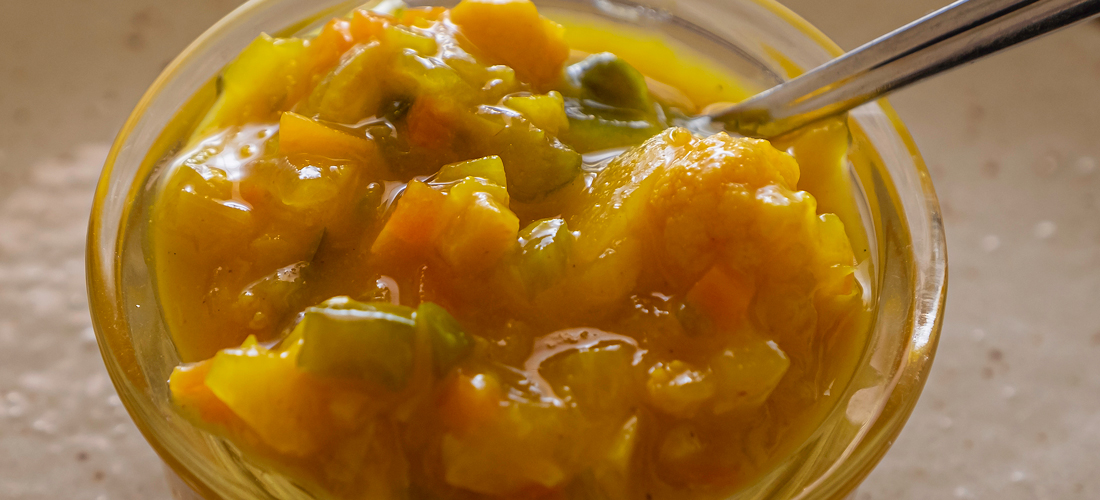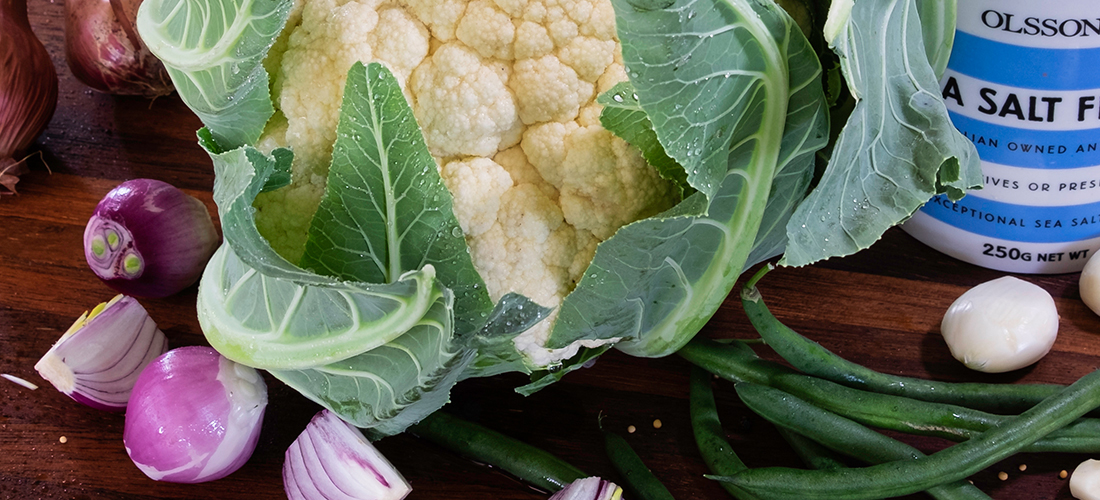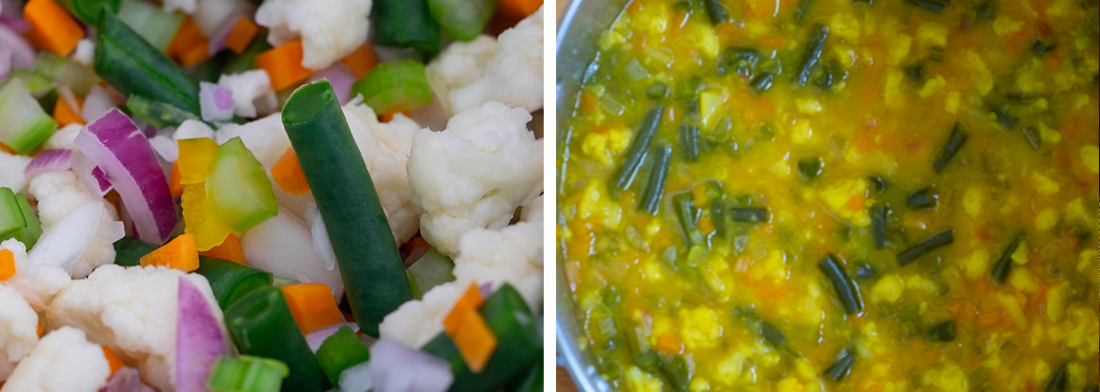Piccalilli : Sweet Mustard Pickles
- Pickles, Chutney, Relish & Sauces

Some know it as piccalilli, others as Indian relish or sweet mustard pickle, either way it’s the perfect pickle. A crunchy assortment of veggies bathed in its signature iridescent yellow and a slight tangy mustard sauce. It’s a British staple traditionally used in sandwiches or with the Ploughman’s Lunch, hamburgers, hot dogs, ham, pork, and cold meat. And always included in the picnic basket. But its versatility doesn’t end there. Add it to omelettes, savoury muffins, and bread, or next to your favourite vegetable curry or dahl. Its origins are a bit of a mystery, but the first known mention of piccalilli was in 1769 in a book The Experienced English Housekeeper. Today, variations are found across the globe in British Commonwealth countries, Cyprus, throughout the United States - each with their own regional influences - and Suriname.
This is Eddie's recipe, hand written and passed down the generations. The vegies were picked from the garden her husband nurtured over the many years they were together. Special thanks to Eddie's daughter for sharing her family favourite as part of my Family Heritage Recipe Collection. The mustard tang and crunchy veggies are delightful.

- Preparation Time:
- 45 minutes plus overnight salting
- Cooking Time:
- 30 minutes
- Quantity:
- 7 x 250 ml jars
INGREDIENTS
- 1
- Large cauliflower
- 450g
- Pickling onions or shallots
- 900g
- Mixed vegetables, green beans, cucumber, red, yellow or green capsicums, zucchini
- 225g
- Pickling salt
- 2.4 litres
- Cold water
- 270g
- White sugar
- 2
- Garlic cloves
- 2 teaspoons
- Mustard powder
- 1 teaspoon
- Ground ginger
- 1.3 litre
- White wine vinegar
- 33g
- Plain flour
- 1 tablespoon
- Ground turmeric

METHOD
Thoroughly wash all vegetables before preparing. Peel the onions or shallots and dice into 5 mm pieces. Cut the capsicums in half, remove the seeds and membrane and dice to the same size. Peel the carrot and zucchini and dice. Divide the cauliflower into small florets and dice the larger central stems. Discard the leaves. Cut the ends of the green beans, then cut into 1.5 cm lengths. All the diced vegetables, excluding cauliflower and beans, should be approximatley the same size.
Place the prepared vegetables in a large bowl and mix. Sprinkle with salt and cover with the cold water. Cover the mixture with clear film, a clean dry tea towel or lid and allow to brine overnight in a cool dry place. The pantry is a good location.
The next day, drain the mixture through a large sieve. Discard the brine. Rinse well in several changes of water, then drain for approximately 10 minutes.
Place the sugar, garlic, mustard, ginger and 900ml of the vinegar into a large preserving pan or heavy-based stainless-steel pan. Place on gentle heat, stirring occasionally, until the sugar is dissolved.
Add the strained vegetables, bring to the boil, then simmer gently until the vegetables are just tender. Do not overcook at this stage as it will be cooked some more in the next step.
Mix flour and turmeric and remaining vinegar to make a smooth lump-free paste. Stir into the vegetable mix and allow to simmer gently for 5-10 minutes or until the mixture thickens. Stir gently to prevent the vegetables from breaking up.
Pour into warm dry sterilised screw cap sealable bottles, filling to approximately 2.5cm (1 inch) from the top of the bottle and seal while hot.
Allow to cool, label, and then store in a cool dark place to mature for 2 weeks before using. Use within a year.
Once opened store in the fridge.
NOTES
- The brined vegetables are strained and rinsed to remove the excess salt. After the last rinse in fresh water, it’s important to drain them thoroughly. This prevents the dilution of the vinegar solution and hence its preserving qualities.
- Do not be tempted to overcook the vegetables in Step 3. Once the turmeric and flour paste has been added, the piccalilli will need to cook further to thicken the base mixture. The flour must be completely cooked otherwise it will have a runny consistency and likely to taste claggy – a description often used to describe the taste of insufficiently cooked flour when used as a thickening agent.
- Salting the vegetables draws out any excess moisture and makes a crisper pickle. The natural calcium and magnesium impurities of unrefined sea salt helps to cross link and reinforce the cell wall pectin’s, creating that allusive crisp pickle you seek.
- Use a good quality sea salt, unrefined, where possible, when preserving. It’s worth hunting around for. Table salt, which is cheap and readily available in supermarkets contains stabilisers and anti-caking agents and often iodide which forms a whitish haze and sediments in pickled vegetable recipes. These additives and in particular iodine can affect the appearance and taste of pickles during the maturation and storage period. The ingestion of a cocktail of anti-caking chemicals such as calcium silicate, sodium silicoaluminate, tricalcium phosphate, magnesium carbonate, silicon dioxide and yellow prussiate of soda, is also unnecessary.
- Lite Salt may be used in quick pickle recipes; however, it may result in a slightly different taste than expected.
- Caution: Use of reduced-sodium salt in fermented pickle recipes is not recommended. The salt creates a favourable environment for the growth of harmful bacteria. The correct concentration of salt is vital to the vegetable texture and food safety.
- Good quality jars should be used in all preserving, particularly when they are processed in a hot water bath. Thin jars often cannot withstand the temperatures and may crack either in the bath or on and or after removal. Avoid the disappointment and invest in some good jars from a homewares store or preserves outlet. Select jars that have non-reactive lids as the vinegar can cause the lids to rust over time.
- Variations
- Piccalilli is ideal for using up a range of abundant garden veggies. Cabbage, broccoli, fennel, kohlrabi, celeriac, different coloured beans, turnip, swede, and other varieties, preferably those with a more robust texture can be used. Experiment with your abundant harvest or when veggies are in plentiful supply.
- Flavour variation. For this recipe’s quantity, simmer 1 tablespoon coriander seeds, 2 tablespoons black or yellow mustard seeds, 2 teaspoons cumin seed and 2 bay leaves with the vinegar for approximately 10 minutes with the lid on the saucepan. Remove from the heat and remove and discard the bay leaf. Vinegar can be strained to remove the seeds, or they can be left in to create additional flavour. Remove a couple of tablespoons of vinegar and allow to cool. This will be used to make the turmeric and flour paste and cold vinegar must be used, or the paste will turn lumpy.
